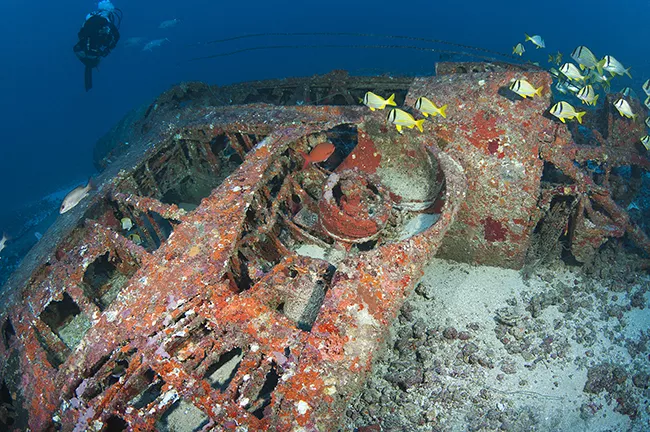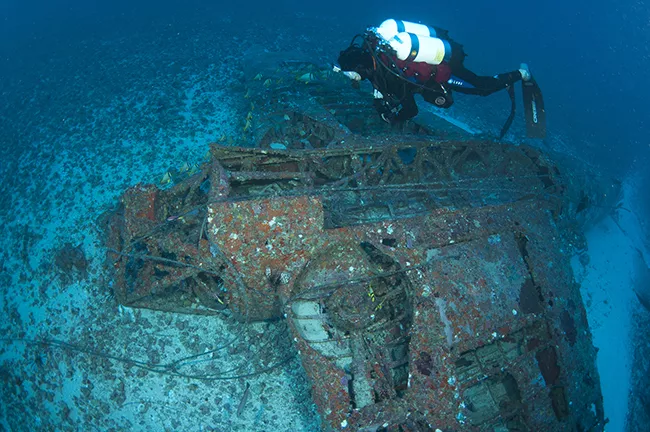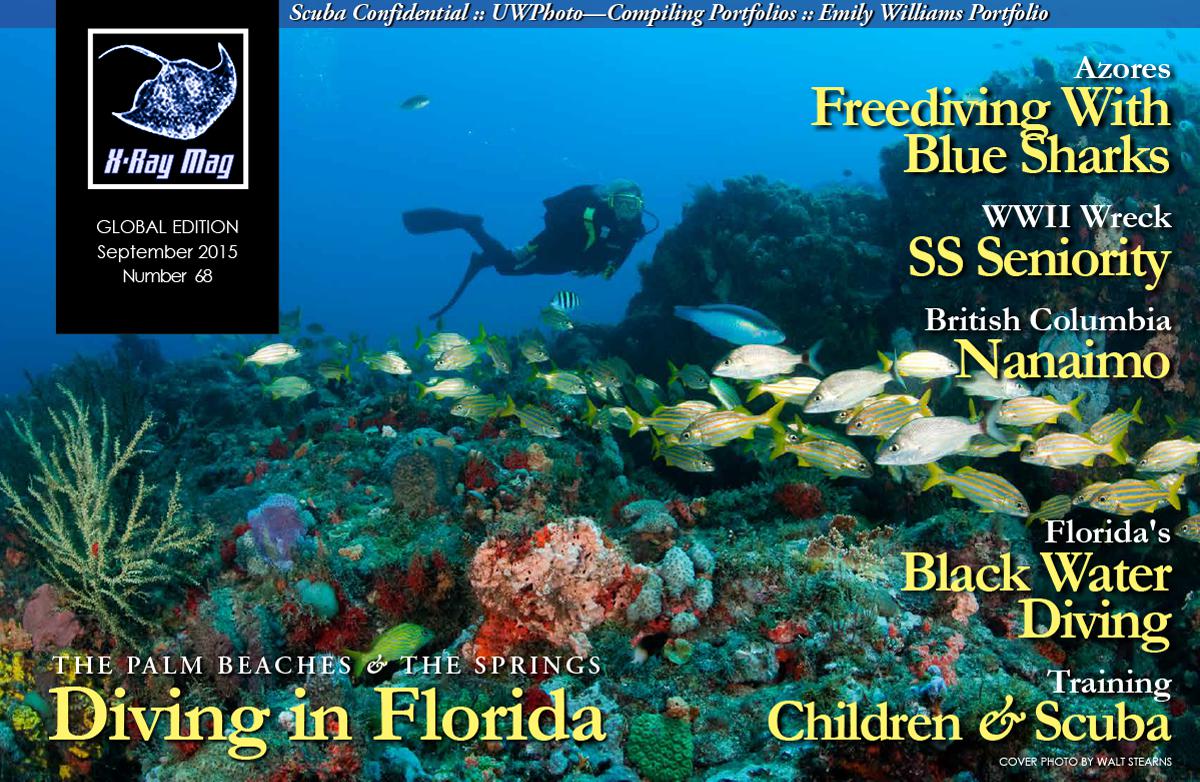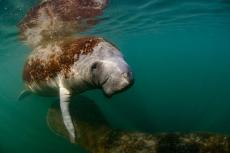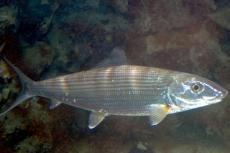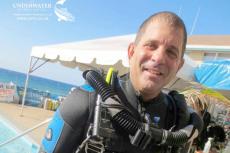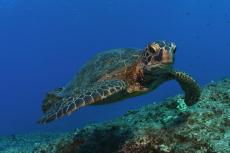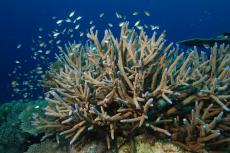Of the numerous types of fighter planes used in WWII, the Curtiss SB2C Helldiver is an incredibility rare aircraft. There is only one remaining in the world that is still in flying condition. Finding one of these largely intact underwater is, to say the least, highly unusual. The first such underwater find was not made until January of 2010, when a scuba shop owner in Maui discovered a Helldiver resting in 50ft (15m) of water in Maalaea Bay. Some 20 months later, a second aircraft was located just north of Palm Beach, Florida. This is the story of its discovery.
Contributed by
Factfile
Walt Stearns is a widely published dive writer, underwater photographer, scuba instructor, certified cave and rebreather diver and an SSI Platinum Pro5000 member based in the US state of Florida.
He is the founder and publisher of the Underwater Journal, soon to be a featured blog on X-RAY MAG at: UnderwaterJournal.com.
For more information about the author, visit: WaltStearns.com.
REFERENCES:
http://www.warbirdinformationexchange.org/
http://en.wikipedia.org/wiki/TBF_Avenger
http://en.wikipedia.org/wiki/PBM_Mariner
http://en.wikipedia.org/wiki/Curtiss_SB2C_Helldiver
http://en.wikipedia.org/wiki/Douglas_SBD_Dauntless
http://en.wikipedia.org/wiki/Palm_Beach_International_Airport
http://en.wikipedia.org/wiki/National_Register_of_Historic_Places
http://en.wikipedia.org/wiki/Bureau_of_Aeronautics
Weather throughout mid-December had become unseasonably calm, generating no more than a moderate chop four miles offshore. Taking advantage of the favorable seas, local dive charter operator Randy Jordan took a perfect opportunity to run his boat, Emerald Diver, a little further offshore to make a couple of deep bounce dives in the 180 to 200ft (55 to 61m) range.
The location for the first drop was an area not previously visited, and Randy simply wanted to see what he might find. “A small group of us had just gotten to the bottom, and we noticed some fish swimming over to the right. Underwater visibility was excellent that day, and the current was carrying us slightly north, so I was able to swim over to see what was there. As I got closer, something came into view low to the bottom, and it was not very big. It wasn’t until I was over the top of it that I realized I was looking down at the fuselage of a plane with its wings and tail still attached, resting upside down on the sea floor. It was the most amazing thing,” said Jordan. “Here it was just sitting there, yet it was the last thing I would ever expect to find out here!”
Identification
Returning the following day for a better look, Randy took several minutes of video, which he posted online in hopes that someone might identify the make and model of the mystery single engine aircraft. One thing was certain: The aircraft appeared to be of a vintage variety and had been down for quite some time, already making the chance of a positive ID difficult.
When vintage aircraft buff Kevin Knebel saw the video, he confirmed the plane was a craft from the Second World War era. “It’s not really that surprising that a WWII plane would be found off Florida,” said Knebel. During the war, there were active air bases up and down the coast. The US Navy had facilities for training pilots at Witham Field just north of Jupiter in Martin County, another south in Fort Lauderdale and a facility in Key West, which is still active today. As such, a fair number of planes—some with the pilots—were lost off our coast; most such losses were a result of training exercise mishaps with mechanical failures.
Historical disappearances
The most infamous disappearance was that of Flight 19. Five Grumman TBM Avenger model torpedo bombers took off out of the Naval Air Station Fort Lauderdale, Florida, on 5 December 1945, on a routine over-water navigation-training mission; they were never heard from again. In addition to the loss of five planes and their crew, a PBM Mariner Flying Boat with a 13-man crew assigned to the search for the five missing Avengers, also vanished without a trace. It was later assumed the larger aircraft might have exploded in mid-air during the course of the search, but no one knows for sure.
The similarity of this plane to the missing Grumman Avengers was hard to ignore. It had obviously been down for some time, was of similar size and had an internal weapons bay for carrying bombs or torpedoes in its belly. As much as our imagination would like it to be otherwise, the mystery aircraft turned out not to be a part of Flight 19. However, Randy’s discovery did turn out to be something equally rare: a Curtiss SB2C Helldiver—identifiable by its broad, rounded wings and large tail.
More questions
Even with the make of the aircraft determined, there were still unanswered questions. Where did it come from and what caused it to end up in 180ft (55m) of water? Were there lives lost?
The simplest way to identify an aircraft is by finding its Bureau of Aeronautics Navy Department (BuAer) number (similar to an automobile VIN or Vehicle Identification Number), issued to every plane built as it rolls off the assembly line. With this, Naval Archives would likely reveal the date the plane was built, as well as who flew it, where it served, and the date it was decommissioned, crashed or shot down.
The BuAer number on a Helldiver is stamped into the data plate located in the cockpit next to the pilot's right elbow. However, even assuming this plane’s data plate had survived decades of submersion, it would be next to impossible to access it, because it is resting upside down on the bottom.
Sunken Military Craft Act
Another component to identifying military aircraft through more than causal observation are directives issued by the Underwater Archaeology Branch (UAB) of the Naval History & Heritage Command (NHHC) known as the Sunken Military Craft Act, which still has jurisdiction on all aircraft and other vintage wrecks. Under the Act, the United States maintains ownership of any sunken military craft and its associated contents owned or operated by the government at the time of its sinking, regardless of the passage of time or location. As a result, it is illegal to disturb, remove or damage sunken military craft, including navy wrecks, as well as foreign government historic wrecks located in US waters, without permission.
The UAB also manages the protection of Navy sunken military craft as, in addition to their historical importance, many of them serve as war graves, carry unexploded ordnance, or may potentially raise environmental concerns. In addition, the UAB maintains a geographic information system and database of over 3,000 ship and 14,000 aircraft wrecks for management as well as prepares nominations for the National Register of Historic Places.
Diving the plane
The challenge in reaching this wreck is not only the depth, but also the fact that it is a small, low profile target sitting on an expansive stretch of sandy bottom directly in the path of the Gulf Stream’s northbound current. The very nature of this wreck’s physical location makes it extremely impractical to anchor nearby and tie in a downline, as the current over the wreck can be more than three knots at any given time.
To compensate for these factors, diving the wreck entails a live drop. Hitting it square on requires both perfect timing and positioning. If the boat captain does not begin the drop directly up current of the plane, divers will miss to the left or right. A drop begun too late will not allow divers time to descend and they overshoot the wreck; a drop too early can waste precious bottom time as divers drift toward the target.
Visibility on the site can range from more than 100ft (30m) to less than 30ft (9m), and when the visibility is down, divers have even less margin for error. There was hard current and 30ft (9m) visibility on my first attempt to dive the wreck, rendering a twilight world on the bottom. A week later, conditions had vastly improved, with visibility opening up to a spectacular 130ft (40m)-plus, along with a mild current pushing ever so lightly north.
On the descent, my first glimpse of the plane reminded me of a child’s discarded toy, with the nose section and propeller off to one side, and the body off to the other. The plane’s current position has it pointing almost due south, nose into the current. Hence, it’s reasonable to say the weight of the engine (the propeller acting like the flukes of an anchor) marked the spot where the plane may have first settled to the bottom. Over time, the continuous buffeting of the current and corrosive actions of the elements weakened the engine’s connection to the airframe, which eventually detached and likely pushed it back to where it now sits.
Mostly intact
For an aluminum aircraft that has been on the sea floor possibly 60-something years, it is still amazingly intact. With the exception of the flaps and parts of the skin having fallen off, both the wings and rear horizontal stabilizers are still firmly attached to the airframe.
Forward of the cockpit, the shroud, known as the nacelle, which once covered the Helldiver’s radial engine, was gone leaving the motor mounts well exposed to the elements and growth. Each pop of my camera strobes revealed vibrant shades of orange with spacklings of deep red produced by years of accumulated growth atop the metal surfaces.
Some 25ft (7.6m) up current from the nose completely inline with the airframe sit the SB2C’s engine with its four-bladed propeller still attached. While this part of the wreck presented some of the more worthy subject matter for imagery, getting some of those shots was also most hazardous.
All around it, like sentries at their post, was a large gathering of lionfish, requiring a few sweeps with my strobe arms to clear a spot to shoot. Getting quilted by even one of their long spines would not be fun, especially with the long deco we would need to perform as part of the dive still to come.
A trail of Accident Reports
To recap, there were several active air bases up and down the Florida coast during and in the years following the Second World War. During those years, every base had lost a few planes to training mishaps and mechanical failures, many of which occurred over water. Without the plane’s BuAer number, the next best source of clues to the plane’s identity is looking at accident reports (at US$15 a pop) from US Naval Archives.
One of the more compelling reports was an incident involving not one but two SBC-3s, which occurred during a practice run on 24 November 1942, some 40 miles (64km) north of Fort Lauderdale, Florida. The details in the report are a bit sketchy, but describe how the plane piloted by Ensign Louie H Steman became interlocked with a second plane as a result of a mid-air collision at an altitude of 1,000ft (305km).
While the occupants of both planes were able to parachute to safety with no serious injuries and “remained afloat by means of life jackets,” the report states: “Both planes were definitely out of control after the collision.”
Going on that last piece of information, the likelihood of either plane remaining even partially intact after that kind of mid-air collision would be slim. Furthermore, the Curtiss SBC-3 was a biplane rather than a single-wing aircraft, so we can safely rule them out.
Another report involved an SB2C-1C lost on 16 January 1945, when Lt. John J Gostovny lost control shortly after takeoff. It was later determined that one of the plane's wing tips may have clipped a tree at the end of the field, in the dark, causing the plane to bank sharply and cartwheel into the neighboring orange grove. An accident like that would have severely mangled both the airframe and wings.
Looking over the Helldiver’s skeletal remains, one could imagine the pilot had performed a wet landing (think US Airways Miracle on the Hudson), as evidenced by the intact airframe and wing, and the fact that the landing gear was still retracted. This brings us to our last current lead—from an accident report filed 3 April 1945. An SB2C-3 model Helldiver, piloted by Lt. T.H. Mewborn made a “wheels up, flaps up” forced landing during his approach into Morrison Field, known today as Palm Beach International Airport.
Among the Helldiver’s less-than-satisfactory handling characteristics is that during a landing approach, the plane would come dangerously close to being out of control. This would sometimes force the pilot to abort the landing and gun the throttles to regain speed and lift. But this action would sometimes cause the plane’s nose to pitch too sharply upwards, causing it to stall over the carrier deck. Other times, the lack of control during approach would cause the plane to stall directly onto the deck. In addition, there were frequent maintenance problems with the Curtiss-Electric propeller, which used a complex hydraulic system that caused the pitch of the propeller to go to near zero upon failure, thereby causing the blades to become ineffective in pulling the plane forward.
Evidence of collision
Studying the sharp bends in two of the wreck’s four propeller blades, with the third exposed blade still straight, it’s obvious this plane hit something hard. In most instances when a prop driven aircraft performs a wet landing, the blades are bent backward, sometimes with little more than subtle curvature to the blade. When the blades hit something harder like earth, the bends are more abrupt, sometimes at sharp right angles as they are here. Without being able to see the condition of the fourth blade, as it is buried deep in the bottom, there is no way of knowing if it too is bent or straight.
Taking in the very visible bends in the propellers and that the fact that landing gear is still retracted and tucked in the wings, it would be conceivable to say this plane could be the same one that crash-landed at Morrison Field in 1945. Other supporting evidence is that control of the airfield had changed hands from the US Army to the US Air Force to the City of West Palm Beach around the turn of 1959 to 1960. During that timeline, several derelict aircraft from the field were supposedly loaded on a barge and dumped well offshore of the Palm Beach Inlet.
Of course, all this is speculation. There is the fact that the military did lose several planes during and for a few years after the war off Florida’s East Coast; plus, we have not exhausted the list of accident reports still under file. Without a solid piece of evidence, like the plane’s BuAer number, we will never know for sure, leaving this warbird mystery wreck, and many others, still unsolved. ■


